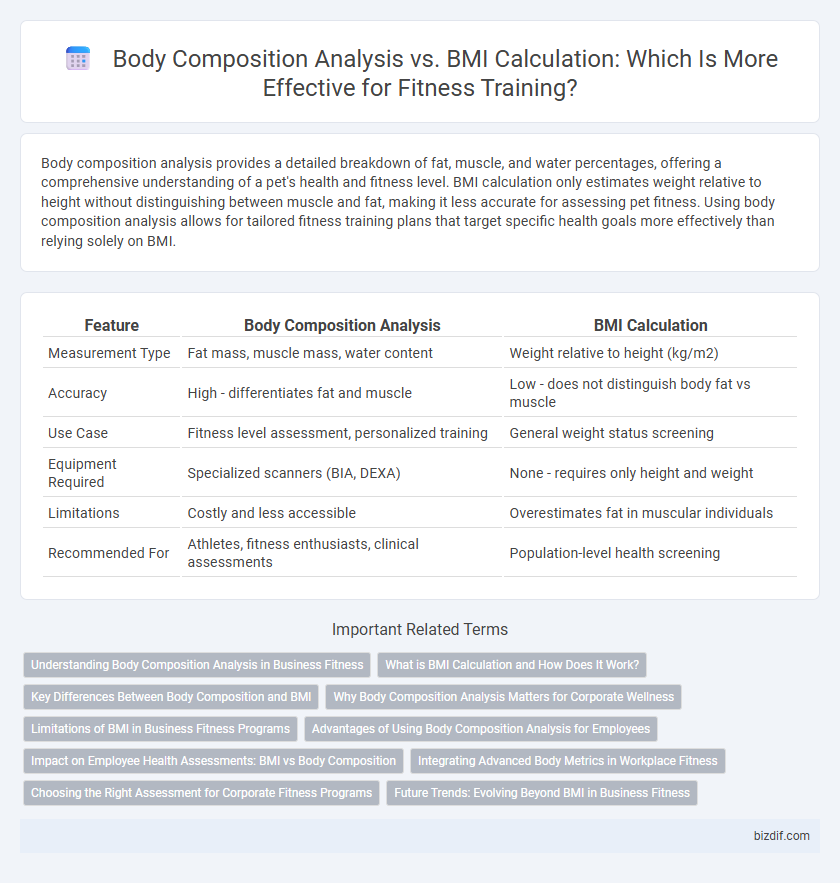Body composition analysis provides a detailed breakdown of fat, muscle, and water percentages, offering a comprehensive understanding of a pet's health and fitness level. BMI calculation only estimates weight relative to height without distinguishing between muscle and fat, making it less accurate for assessing pet fitness. Using body composition analysis allows for tailored fitness training plans that target specific health goals more effectively than relying solely on BMI.
Table of Comparison
| Feature | Body Composition Analysis | BMI Calculation |
|---|---|---|
| Measurement Type | Fat mass, muscle mass, water content | Weight relative to height (kg/m2) |
| Accuracy | High - differentiates fat and muscle | Low - does not distinguish body fat vs muscle |
| Use Case | Fitness level assessment, personalized training | General weight status screening |
| Equipment Required | Specialized scanners (BIA, DEXA) | None - requires only height and weight |
| Limitations | Costly and less accessible | Overestimates fat in muscular individuals |
| Recommended For | Athletes, fitness enthusiasts, clinical assessments | Population-level health screening |
Understanding Body Composition Analysis in Business Fitness
Body Composition Analysis provides a detailed breakdown of fat, muscle, and water percentages, offering precise insights into an individual's physical health beyond traditional BMI Calculation. In business fitness programs, leveraging Body Composition Analysis allows for personalized training plans that enhance employee wellness and productivity by targeting specific health metrics. This advanced measurement supports better tracking of fitness progress and overall health improvements, making it essential for effective corporate wellness strategies.
What is BMI Calculation and How Does It Work?
BMI calculation is a simple metric that estimates body fat based on height and weight, dividing weight in kilograms by height in meters squared. This method categorizes individuals into underweight, normal weight, overweight, or obese ranges, providing a quick assessment tool for population studies. However, BMI does not account for muscle mass, bone density, or fat distribution, limiting its accuracy for personal fitness and health evaluations.
Key Differences Between Body Composition and BMI
Body composition analysis measures the percentages of fat, muscle, bone, and water in the body, providing a detailed view of physical health, while BMI calculation only uses height and weight to estimate overall body mass. Unlike BMI, which can misclassify muscular individuals as overweight, body composition analysis offers precise insights into muscle mass and fat distribution. This distinction is critical for fitness training, as body composition guides personalized workout and nutrition plans more effectively than BMI alone.
Why Body Composition Analysis Matters for Corporate Wellness
Body composition analysis provides detailed insights into fat mass, muscle mass, and hydration levels, offering a more accurate assessment of an employee's health compared to traditional BMI calculations, which only consider weight relative to height. Corporations using body composition data can tailor wellness programs to individual needs, improving overall employee health, reducing absenteeism, and enhancing productivity. Investing in body composition analysis empowers organizations to monitor progress effectively and create targeted interventions that foster long-term wellness benefits.
Limitations of BMI in Business Fitness Programs
Body composition analysis provides a more precise measurement of fat, muscle, and bone mass compared to BMI calculation, which only considers weight relative to height without differentiating muscle from fat. Relying solely on BMI in business fitness programs can misclassify muscular employees as overweight or obese, undermining personalized health assessments. Integrating body composition analysis enhances program accuracy, enabling tailored interventions that improve employee health outcomes and productivity.
Advantages of Using Body Composition Analysis for Employees
Body composition analysis provides detailed insights into fat mass, muscle mass, and bone density, offering a comprehensive assessment of employees' health beyond the limitations of BMI calculation. This advanced method allows fitness trainers and employers to tailor wellness programs effectively, targeting specific areas for improvement and enhancing overall employee well-being. By utilizing body composition analysis, organizations can improve health outcomes, reduce risk of metabolic diseases, and boost productivity through personalized fitness interventions.
Impact on Employee Health Assessments: BMI vs Body Composition
Body Composition Analysis provides a more accurate assessment of an employee's health by measuring fat, muscle, and bone mass, unlike BMI calculation which only considers height and weight ratios. This detailed insight helps tailor fitness programs and monitor progress effectively, reducing the risk of misclassification seen with BMI, particularly in muscular individuals. Employers using Body Composition Analysis can implement more personalized health interventions, leading to better outcomes in workplace wellness initiatives.
Integrating Advanced Body Metrics in Workplace Fitness
Body Composition Analysis provides a detailed assessment of fat, muscle, and bone mass, offering precise insights beyond the traditional BMI calculation used in workplace fitness programs. Integrating advanced metrics such as visceral fat percentage and metabolic age enables personalized training plans that target specific health goals and improve employee wellness outcomes. Utilizing tools like bioelectrical impedance analysis (BIA) or dual-energy X-ray absorptiometry (DEXA) enhances the accuracy of fitness monitoring and supports data-driven health initiatives in corporate environments.
Choosing the Right Assessment for Corporate Fitness Programs
Body composition analysis provides a detailed breakdown of fat, muscle, and water percentages, offering a more accurate assessment of employee health compared to BMI calculation, which only considers weight relative to height. For corporate fitness programs aiming to tailor workouts and nutrition plans effectively, body composition metrics enable personalized interventions that can improve workplace wellness and productivity. Selecting body composition analysis over BMI supports targeted goal setting and tracks meaningful progress in employee fitness initiatives.
Future Trends: Evolving Beyond BMI in Business Fitness
Body composition analysis offers a more precise assessment of health metrics by measuring fat percentage, muscle mass, and water content, surpassing the limitations of BMI's reliance on height and weight ratios. Future trends in business fitness emphasize integrating advanced technologies like bioelectrical impedance analysis and 3D body scanning to provide individualized health insights. This shift enables corporate wellness programs to tailor interventions for improved employee performance, engagement, and long-term health outcomes.
Body Composition Analysis vs BMI Calculation Infographic

 bizdif.com
bizdif.com